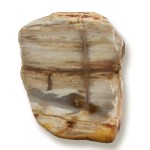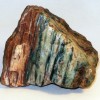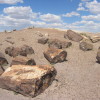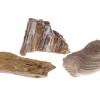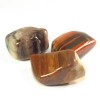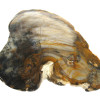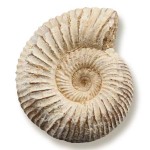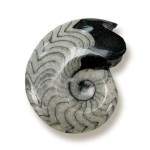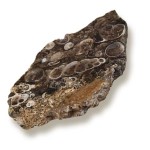Product Description
FOUND AROUND THE WORLD.
Petrified wood (from the Greek root petro meaning “rock” or “stone”; literally “wood turned into stone”) is the name given to a special type of fossilized remains of terrestrial vegetation. It is the result of a tree or tree-like plants having completely transitioned to stone by the process of permineralization. All the organic materials have been replaced with minerals (mostly asilicate, such as quartz), while retaining the original structure of the stem tissue. Unlike other types of fossils which are typically impressions or compressions, petrified wood is a three-dimensional representation of the original organic material. The petrifactionprocess occurs underground, when wood becomes buried under sediment and is initially preserved due to a lack of oxygen which inhibits aerobic decomposition. Mineral-laden water flowing through the sediment deposits minerals in the plant’s cells; as the plant’s lignin and cellulose decay, a stone mould forms in its place. The organic matter needs to become petrified before itdecomposes completely. A forest where such material has petrified becomes known as a petrified forest.
Elements such as manganese, iron, and copper in the water/mud during the petrification process give petrified wood a variety of color ranges. Pure quartz crystals are colorless, but when contaminants are added to the process the crystals take on a yellow, red, or other tint.
Following is a list of contaminating elements and related color hues:
- carbon – black
- cobalt – green/blue
- chromium – green/blue
- copper – green/blue
- iron oxides – red, brown, and yellow
- manganese – pink/orange
- manganese oxides – blackish/yellow
Petrified wood is a fossil in which the organic remains have been replaced by minerals in the slow process of being replaced with stone. This petrification process generally results in a Quartz Chalcedony mineralization. Special rare conditions must be met in order for the fallen stem to be transformed into Fossil Wood or Petrified Wood. In general, the fallen plants get buried in an environment free of oxygen (anaerobic environment), which preserves the original plant structure and general appearance. The other conditions include a regular access to mineral rich water flowing through the tissues, replacing the organic plant structure with inorganic stone. The end result is petrified wood, a plant, with its original basic structure in place, replaced by stone. This process could occur in less than one thousand years.[citation needed] Exotic minerals allow the rare red and green hues that can be seen in more rare specimens.
Locations
Areas with a large number of petrified trees include:
- Argentina – the Petrified Forest National Monument in Santa Cruz Province in the Argentine Patagonia has many trees that measure more than 3 m (10 ft) in diameter and 30 m (100 ft) long.
- Australia – has deposits of petrified and opalised wood. Chinchilla, Queensland is famous for its ‘Chinchilla Red’.
- Belgium – Geosite Goudberg near Hoegaarden.
- Brazil – in the geopark of Paleorrota, there is a vast area with petrified trees.
- Canada – in the badlands of southern Alberta; Petrified wood is the provincial stone of Alberta. Axel Heiberg Island in Nunavuthas a large petrified forest.
- China – in the Junggar Basin of Xinjiang, northwest China government has issued a crackdown on collecting of this material, but large slabs and even large meeting tables have been made out of the colorful petrified wood.
- Czech Republic, Nová Paka – The most famous locality on Permian–Carboniferous rocks in the Czech Republic.
- Germany – the museum of natural history in Chemnitz has a collection of petrified trees, from the in situ Chemnitz Petrified Forest, found in the town since 1737.
- Ecuador – Puyango petrified forest. One of the largest collections of petrified wood in the world.
- Egypt – petrified forest in Cairo-Suez road, declared a national protectorate by the minstery of environment, also in the area of New Cairo at the Extension of Nasr city, El Qattamiyya, near El Maadi district, and Al Farafra oasis.
- France – petrified forest in the village of Champclauson
- Greece – Petrified Forest of Lesvos, at the western tip of the island of Lesbos, is possibly the largest of the petrified forests, covering an area of over 150 km² and declared a National Monument in 1985. Large, upright trunks complete with root systems can be found, as well as trunks up to 22 m in length.
- India – a geological site known for its petrified wood Thiruvakkarai Village in Chennai, Tamil Nadu. The site is protected by theGeological Survey of India. Petrified wood covers a large area in this site.
- Indonesia – petrified wood covers several area in Banten and also in some part of Mount Halimun Salak National Park.
- Israel – several examples of petrified wood occur in the HaMakhtesh HaGadol in the Negev desert.
- Libya – Great Sand Sea – Hundreds of square miles of petrified trunks, branches and other debris mixed with Stone Age artifacts
- Namibia – petrified forest of Damaraland
- New Zealand:
- Curio Bay on the Catlins coast contains many petrified wood examples.
- Fossil Forest, Takapuna, Auckland, New Zealand
- Saudi Arabia – petrified forest north of Riyadh
- Thailand – Bantak Petrified Forest Park in Ban Tak District
- Ukraine – petrified araucaria trunks near Druzhkivka
- United Kingdom – many examples of petrified submerged forests can be found at low tide around the coast of England and Wales.[8]
- Fossil Forest, Dorset, England
- United States – petrified wood sites include:
- Petrified Wood Park in Lemmon, South Dakota.
- Ginkgo/Wanapum State Park in Washington State.
- Petrified Forest National Park in Arizona.
- Petrified Forest (California) in California.
- Mississippi Petrified Forest in Flora, Mississippi.
- Florissant Fossil Beds National Monument near Florissant, Colorado.
- Yellowstone Petrified Forest, Yellowstone National Park, Wyoming.
- Gallatin Petrified Forest, Yellowstone National Park, Wyoming.
- The south unit of Theodore Roosevelt National Park outside Medora, North Dakota.
- Gilboa Fossil Forest, New York.
- Escalante Petrified Forest State Park in Utah.
- Petrified Springs in Kenosha, Wisconsin.

